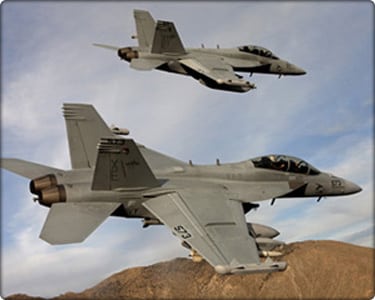
A pair of Boeing EA-18G Growlers bank over the desert. File photo
The Royal Australian Air Force and the U.S. Naval Air Warfare Center Weapons Division (NAWCWD) have completed a large-scale, joint test and evaluation deployment, the Weapons Division said. Australia is currently working to declare initial operating capability for its new Boeing EA-18G Growler.
Exercises were conducted at China Lake and Point Mugu, in California, using Boeing F/A-18 Super Hornets as well as Growlers.
“It’s been an almost two-year iteration of planning,” said Grady Baker, Australia case manager. “They were able to fire all of the weapons that they’d planned to shoot and got all the hours they wanted. It was a really successful event for them and it was the largest scale, varied scope that the NAWCWD Foreign Military Sales and Advance Weapons Laboratory have done in support of foreign partners.”
These tests included live fire of multiple weapons on the Land Range and Sea Range, the Weapons Division said, as well as warfare testing at the China Lake Electronic Combat Range. Exercises were conducted with support from Whidbey Island personnel and Electronic Attack Squadron (VAQ) 135.
“The RAAF were able to exercise and rehearse operational tactics against our Range threats,” Baker said. “Another big part of that is interoperability between the RAAF Super Hornet and the RAAF Growler because, up to now, they hadn’t taken the Growlers ‘Down Under’ yet. The newly delivered Growlers have been performing workup flights while located at Naval Air Station Whidbey Island where their Australian aircrews and maintainers have been stationed since 2016. Having the squadron pilots from both aircraft being able to talk was a first for them.”
The Royal Australian Air Force and the Weapons Division have been working together for nearly 30 years, the Weapons Division said. It has been responsible for a significant amount of the testing and development the two aircraft have undergone.
“The unique thing that this brought is the Australian operational side of the house,” said Harlan Kooima, director of NAWCWD software and mission systems integration. “We’ve done work with the science and technology organizations in Australia, the acquisition team, and development that we’ve supported over the years, but this event really got into the Australian operational realm, which was quite different for us.”
While in California, the Royal Australian Air Force participated in a ribbon-cutting ceremony for the new Trans-Pacific Electronic Attack Research Lab.